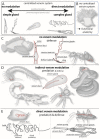The Diversity of Venom: The Importance of Behavior and Venom System Morphology in Understanding Its Ecology and Evolution
- PMID: 31739590
- PMCID: PMC6891279
- DOI: 10.3390/toxins11110666
The Diversity of Venom: The Importance of Behavior and Venom System Morphology in Understanding Its Ecology and Evolution
Abstract
Venoms are one of the most convergent of animal traits known, and encompass a much greater taxonomic and functional diversity than is commonly appreciated. This knowledge gap limits the potential of venom as a model trait in evolutionary biology. Here, we summarize the taxonomic and functional diversity of animal venoms and relate this to what is known about venom system morphology, venom modulation, and venom pharmacology, with the aim of drawing attention to the importance of these largely neglected aspects of venom research. We find that animals have evolved venoms at least 101 independent times and that venoms play at least 11 distinct ecological roles in addition to predation, defense, and feeding. Comparisons of different venom systems suggest that morphology strongly influences how venoms achieve these functions, and hence is an important consideration for understanding the molecular evolution of venoms and their toxins. Our findings also highlight the need for more holistic studies of venom systems and the toxins they contain. Greater knowledge of behavior, morphology, and ecologically relevant toxin pharmacology will improve our understanding of the evolution of venoms and their toxins, and likely facilitate exploration of their potential as sources of molecular tools and therapeutic and agrochemical lead compounds.
Keywords: Venom diversity; defense; predation; toxin function; venom gland; venom metering; venom optimization.
Conflict of interest statement
The authors declare no conflict of interest. The funders had no role in the design of the study; in the collection, analyses, or interpretation of data; in the writing of the manuscript, or in the decision to publish the results.
Figures


References
-
- Fry B.G., Koludarov I., Jackson T.N.W., Holford M., Terrat Y., Casewell N.R., Undheim E.A.B., Vetter I., Ali S.A., Low D.H.W., et al. Seeing the Woods for the Trees: Understanding Venom Evolution as a Guide for Biodiscovery. In: King G.F., editor. Venoms to Drugs: Venom as a Source For the Development of Human Therapeutics. Royal Society of Chemistry; London, UK: 2015. pp. 1–36.
Publication types
MeSH terms
Substances
Grants and funding
LinkOut - more resources
Full Text Sources
Miscellaneous

